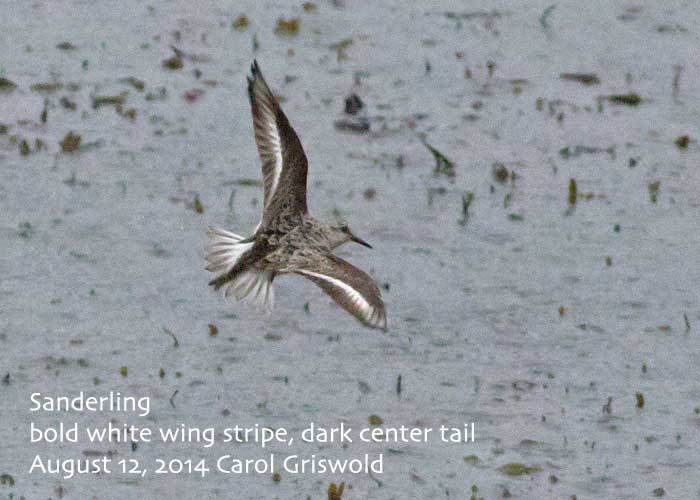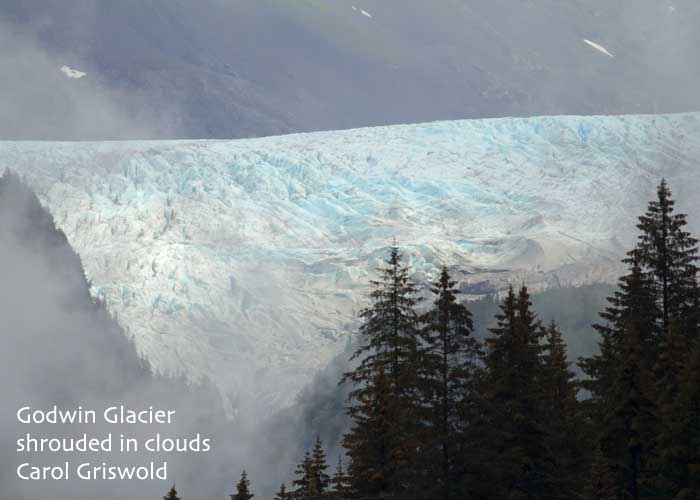The rain continued, and the
answer to the rhetorical, "Can it rain any harder?" was a hammering
YES! But the incredible resultant downpour seemed to drain the clouds'
reservoir, and the rest of the day's delivery was lighter with welcome pauses.
I checked out Fourth of July
Beach in the afternoon, looking for the STELLER'S EIDER. I found the usual dark
male HARLEQUIN DUCKS in their eclipse plumage, growing their tails from odd,
long pins. A much lighter female Harlequin paddled and dove with them, only
one. The females have been scarce. She could be mistaken for the Eider as they
are both a light brown, and stand out among the male Harleys. But note her
rounded head, face pattern, small bill, and she is the same size as the males.
Next, I checked out nearby
Spring Creek beach. The STELLER'S EIDER was indeed there, just offshore,
hanging out with a long line of male Harlequins. Slightly larger, lighter
brown, flat head, longer bill, with different but subtle patterning.
Suddenly, a powerful, large
brown raptor zoomed past my car. A PEREGRINE FALCON!! I haven't seen one all
year! That was exciting! It disappeared as quickly as
it came.
Another surprise awaited:
swooping over the wetland pond were a dozen SWALLOWS! I thought the swallows
were long gone. It took a lot of effort to try to track them in the rain and
dim light and getting a photo was even more challenging. They are more erratic
than bats! Finally, I caught sight of a dark breast band and identified at
least a few as BANK SWALLOWS. I think some others may have been TREE SWALLOWS
but it sure was hard to tell.
A flash of brown in the
wetlands beyond caught my eye next: a SHARP-SHINNED HAWK in pursuit of a
rattling, protesting BELTED KINGFISHER! After a short dash, the hawk veered off
to settle on one of the dead trees nearby. NORTHWESTERN CROWS perched on top of various other dead trees watching the show. But there was more!
A MERLIN shot into the scene,
chasing the Sharpie. Round and round they went, until the Merlin gave up and
the Sharpie landed to catch its breath. The Merlin perched upright on top of a
dead tree snag, and the Sharpie sat not 10' below it, in a slightly less
upright posture. Waiting, watching, resting. While they sat, I checked around
the clearing and found the PEREGRINE FALCON sitting on another dead tree, waiting and watching. What
a lot of raptors!
After a time-out, ANOTHER
Sharp-shinned Hawk materialized and took off after the first. They both chased
around the clearing, dodging the dead branches and then through the nearby live
spruce tree branches. They seemed pretty serious about the chase, flaring their
wings and extending their yellow legs and sharp talons.
By the time they dashed off
through the trees one final time, I lost track of the Merlin and Peregrine. The
Crows and Kingfisher had disappeared too, smart birds!
Even though the rain made it
tough to get decent photos, and the action was far away, it sure was an
exciting afternoon and well worth the effort.
Happy Birding!
Carol Griswold
Seward Sporadic Bird Report
Reporter


























